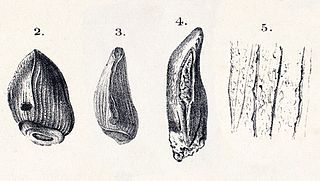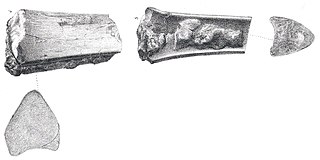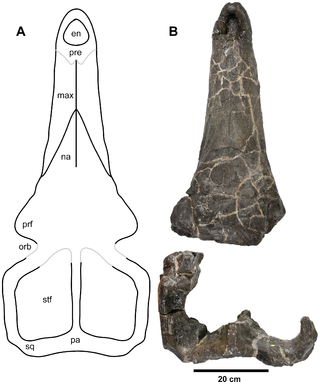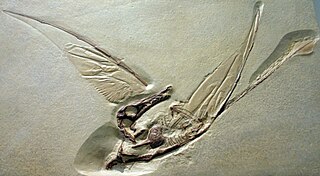
Pterodactylus is an extinct genus of pterosaurs. It is thought to contain only a single species, Pterodactylus antiquus, which was the first pterosaur to be named and identified as a flying reptile.

Rhamphorhynchus is a genus of long-tailed pterosaurs in the Jurassic period. Less specialized than contemporary, short-tailed pterodactyloid pterosaurs such as Pterodactylus, it had a long tail, stiffened with ligaments, which ended in a characteristic soft-tissue tail vane. The mouth of Rhamphorhynchus housed needle-like teeth, which were angled forward, with a curved, sharp, beak-like tip lacking teeth, indicating a diet mainly of fish; indeed, fish and cephalopod remains are frequently found in Rhamphorhynchus abdominal contents, as well as in their coprolites.
Liopleurodon is an extinct genus of large, carnivorous marine reptile belonging to the Thalassophonea, a clade of short-necked pliosaurid plesiosaurs. Liopleurodon lived from the Callovian Stage of the Middle Jurassic to the Kimmeridgian stage of the Late Jurassic Period. It was the apex predator of the Middle to Late Jurassic seas that covered Europe. The largest species, L. ferox, is estimated to have grown up to 6.6 metres (22 ft) in length based on the largest known skull.

Dimorphodon was a genus of medium-sized pterosaur from the early Jurassic Period. It was named by paleontologist Richard Owen in 1859. Dimorphodon means "two-form tooth", derived from the Greek δι meaning "two", μορφη meaning "shape" and οδων meaning "tooth", referring to the fact that it had two distinct types of teeth in its jaws – which is comparatively rare among reptiles. Dimorphodon inhabited Europe.

Echinodon is a genus of heterodontosaurid dinosaur that lived during the earliest Cretaceous of southern England and possibly western France in the Berriasian epoch. The first specimens were jaw bones named Echinodon becklesii by Sir Richard Owen in 1861, and since their original description only additional teeth have been discovered. The specific name honours collector Samuel Beckles who discovered the material of Echinodon and many other taxa from across England, while the genus name translates as "prickly tooth" in reference to the dental anatomy of the taxon.

Cardiodon was a herbivorous genus of sauropod dinosaur, based on a tooth from the late Bathonian-age Middle Jurassic Forest Marble Formation of Wiltshire, England. Historically, it is very obscure and usually referred to Cetiosaurus, but recent analyses suggest that it is a distinct genus, and possibly related to Turiasaurus. Cardiodon was the first sauropod genus named.

Sordes was a small pterosaur from the late Jurassic (Oxfordian/Kimmeridgian) Karabastau Svita of Kazakhstan.
Peloneustes is a genus of pliosaurid plesiosaur from the Middle Jurassic of England. Its remains are known from the Peterborough Member of the Oxford Clay Formation, which is Callovian in age. It was originally described as a species of Plesiosaurus by palaeontologist Harry Govier Seeley in 1869, before being given its own genus by naturalist Richard Lydekker in 1889. While many species have been assigned to Peloneustes, P. philarchus is currently the only one still considered valid, with the others moved to different genera, considered nomina dubia, or synonymised with P. philarchus. Some of the material formerly assigned to P. evansi have since been reassigned to "Pliosaurus" andrewsi. Peloneustes is known from many specimens, including some very complete material.

Rhamphocephalus is an extinct genus of fossil reptile from the Middle Jurassic Great Oolite Group of Gloucestershire, England. The name was erected as a genus of pterosaur and became a 'wastebasket taxon' for British Jurassic pterosaur remains until a recent revision. Rhamphocephalus comprises several named species, two of which are pterosaurian, but the type species - R. prestwichi - is based on remains now identified as a thalattosuchian. Because it is poorly preserved and lacks features that distinguish it from other thalattosuchians, R. prestwichi is considered an invalid species and the genus Rhamphocephalus is a nomen dubium. Reassessments of other Rhamphocephalus species suggest they are also undiagnostic to species level, although they have properties allowing referral to some Jurassic pterosaur groups.

Pliosaurus is an extinct genus of thalassophonean pliosaurid known from the Kimmeridgian and Tithonian stages of Europe and South America. Their diet would have included fish, cephalopods, and marine reptiles. This genus has contained many species in the past but recent reviews found only six to be valid, while the validity of two additional species awaits a petition to the International Code of Zoological Nomenclature. Currently, P. brachyspondylus and P. macromerus are considered dubious, while P. portentificus is considered undiagnostic. Most species of Pliosaurus reached 8 metres (26 ft) in length and 5 metric tons in body mass, while P. rossicus and P. funkei may have reached or even exceeded 10 metres (33 ft) in length and 11 metric tons in body mass, being the largest plesiosaurs of all time. Species of this genus are differentiated from other pliosaurids based on seven autapomorphies, including teeth that are triangular in cross section.

Campylognathoides is an extinct genus of pterosaur discovered in the Württemberg Lias deposits of Germany; this first specimen however, consisted only of wing fragments. Further better preserved specimens were found in the Holzmaden shale; based on these specimens, Felix Plieninger erected a new genus.

Ornithostoma is a genus of pterodactyloid pterosaur that lived during the Early Cretaceous period of Europe, around 110 million years ago. Ornithostoma was once thought to have been a senior synonym of the pteranodontid Pteranodon due to its toothless anatomy and prior naming.

Istiodactylus is a genus of pterosaur that lived during the Early Cretaceous period, about 120 million years ago. The first fossil was discovered on the English Isle of Wight in 1887, and in 1901 became the holotype specimen of a new species, O. latidens, in the genus Ornithodesmus. This species was moved to its own genus, Istiodactylus, in 2001; this name is Greek for "sail finger". More specimens were described in 1913, and Istiodactylus was the only pterosaur known from three-dimensionally preserved fossils for much of the 20th century. In 2006, a species from China, I. sinensis, was assigned to Istiodactylus, but it has also been suggested to belong to a different genus.

Plesiosuchus is an extinct genus of geosaurine metriorhynchid crocodyliform known from the Late Jurassic of Dorset, England and possibly also Spain. It contains a single species, Plesiosuchus manselii.

Dolicorhamphus is an extinct genus of pterosaurs from the Middle Jurassic Taynton Limestone Formation and Fuller's Earth Formations of England. The genus contains two species, D. bucklandii and D. depressirostris.

Rhamphorhynchidae is a group of early pterosaurs named after Rhamphorhynchus, that lived in the Late Jurassic. The family Rhamphorhynchidae was named in 1870 by Harry Govier Seeley. Members of the group possess no more than 11 pairs of teeth in the rostrum, a deltopectoral crest that is constricted at the base but expanded at the distal end, and a bent phalange on the fifth toe.

Bellubrunnus is an extinct genus of rhamphorhynchid pterosaur from the Late Jurassic of southern Germany. It contains a single species, Bellubrunnus rothgaengeri. Bellubrunnus is distinguished from other rhamphorhynchids by its lack of long projections on the vertebrae of the tail, fewer teeth in the jaws, and wingtips that curve forward rather than sweep backward as in other pterosaurs.

Cimoliopterus is a genus of pterosaur that lived during the Late Cretaceous in what is now England and the United States. The first known specimen, consisting of the front part of a snout including part of a crest, was discovered in the Grey Chalk Subgroup of Kent, England, and described as the new species Pterodactylus cuvieri in 1851. The specific name cuvieri honours the palaeontologist George Cuvier, whereas the genus Pterodactylus was then used for many pterosaur species that are not thought to be closely related today. It was one of the first pterosaurs to be depicted as models in Crystal Palace Park in the 1850s. The species was subsequently assigned to various other genera, including Ornithocheirus and Anhanguera. In 2013, the species was moved to a new genus, as Cimoliopterus cuvieri; the generic name Cimoliopterus is derived from the Greek words for "chalk" and "wing". Other specimens and species have also been assigned to or synonymised with the species with various levels of certainty. In 2015, a snout discovered in the Britton Formation of Texas, US, was named as a new species in the genus, C. dunni; the specific name honours its collector, Brent Dunn.

Lonchodraco is a genus of lonchodraconid pterodactyloid pterosaur from the Late Cretaceous of southern England. The genus includes species that were previously assigned to other genera.

Camposipterus is a genus of pterodactyloid pterosaur from the Early Cretaceous of England. Fossil remains of Camposipterus dated back to the Early Cretaceous, about 112 million years ago.































